
|
Vol. 46, Issue No. 145 |
|
| St. Rose of Viterbo |
Notre Dame de Puy
(Pronounced "Pwee.")
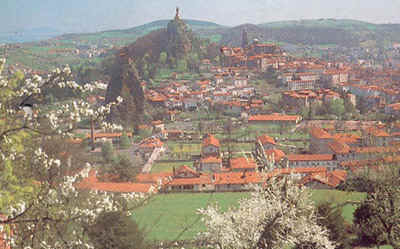 The history of the venerable church of Puy presents us with one of the first instances on record of an Apparition of the Blessed Virgin. According to French historians, in the year 46 or 47 Anno Domini, the first missionaries were sent into Gaul by St. Peter, and amongst these St. George of Velay, as he is commonly called, became the first Bishop of that See. In approximately the year 70, one of the new converts, a certain devout widow named Villa, being sick with a fever, invoked the aid of Our Blessed Lady, and was consoled by a vision in which the Blessed Virgin desired her to ascend a certain hill in the neighborhood, then called Anis, which she had chosen as the site of a future sanctuary to be erected in her honor, promising her that she should there be cured. Villa obeyed the command, and made her attendant carry her to the spot indicated, where, being laid to rest on a large stone, she fell asleep, and awoke in perfect health.
The history of the venerable church of Puy presents us with one of the first instances on record of an Apparition of the Blessed Virgin. According to French historians, in the year 46 or 47 Anno Domini, the first missionaries were sent into Gaul by St. Peter, and amongst these St. George of Velay, as he is commonly called, became the first Bishop of that See. In approximately the year 70, one of the new converts, a certain devout widow named Villa, being sick with a fever, invoked the aid of Our Blessed Lady, and was consoled by a vision in which the Blessed Virgin desired her to ascend a certain hill in the neighborhood, then called Anis, which she had chosen as the site of a future sanctuary to be erected in her honor, promising her that she should there be cured. Villa obeyed the command, and made her attendant carry her to the spot indicated, where, being laid to rest on a large stone, she fell asleep, and awoke in perfect health.
The facts being made known to St. George, he proceeded to the spot in company with his clergy, but when they came in sight of the rock, they paused in surprise. It was a hot summer's day, the 11th of July, but Mount Anis was covered with a sparkling veil of freshly-fallen snow. As they gazed in wonder at so strange a spectacle, a stag sprang out of a nearby thicket, and, with light steps bounded round the rock, and then galloped back to his woody covert, leaving on the snow traces of his feet. St. George directed the area thus marked out to be enclosed by a hedge, and St. Martial afterwards chose the place to be occupied by the altar of the future church, and left, as a precious relic to be preserved in it forever, one of the sandals of the Blessed Virgin, which he had brought from Rome.
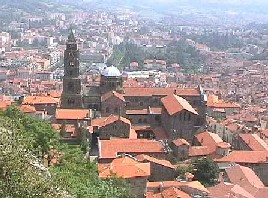 Nevertheless, it was not until the episcopate of St. Vosy, or Evodius, that the church was commenced. Another miraculous cure wrought on the person of a paralytic woman when laid upon the same stone convinced him in 221, as early writers confirm, to build a church, and fix his Episcopal See at Anis. The authorization of the Pope was necessary, for which purpose Evodius journeyed to Rome, and returned in company with a young Roman architect named Scutarius. In seven years they completed building the round apse and cupola now occupied by the choir stalls, and commonly called "the Angelic Chamber." When it was finished, the Bishop again set out for Rome, accompanied by his architect, to solicit permission for its solemn consecration, but they had not proceeded half a league, when they met two venerable old men, each carrying a gilded casket. The caskets contained relics brought from Rome, they said, which they presented to the Bishop, desiring him to deposit them in the church of Mount Anis, which at that moment they assured him was being consecrated by the hands of the angels. They then disappeared, and the Bishop returning barefoot to his church, found it illuminated by 300 torches, and the altar still anointed with an oil of delicious fragrance. Two of these torches are still exhibited in the treasury of Puy; the church never received any other consecration, and has henceforth borne the title of the Church of the Angels.
Nevertheless, it was not until the episcopate of St. Vosy, or Evodius, that the church was commenced. Another miraculous cure wrought on the person of a paralytic woman when laid upon the same stone convinced him in 221, as early writers confirm, to build a church, and fix his Episcopal See at Anis. The authorization of the Pope was necessary, for which purpose Evodius journeyed to Rome, and returned in company with a young Roman architect named Scutarius. In seven years they completed building the round apse and cupola now occupied by the choir stalls, and commonly called "the Angelic Chamber." When it was finished, the Bishop again set out for Rome, accompanied by his architect, to solicit permission for its solemn consecration, but they had not proceeded half a league, when they met two venerable old men, each carrying a gilded casket. The caskets contained relics brought from Rome, they said, which they presented to the Bishop, desiring him to deposit them in the church of Mount Anis, which at that moment they assured him was being consecrated by the hands of the angels. They then disappeared, and the Bishop returning barefoot to his church, found it illuminated by 300 torches, and the altar still anointed with an oil of delicious fragrance. Two of these torches are still exhibited in the treasury of Puy; the church never received any other consecration, and has henceforth borne the title of the Church of the Angels.
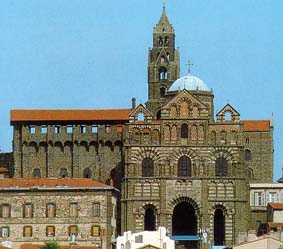 As the population increased, and a city gradually gathered round the foot of the mountain, the apse of St. Evodius was found to be far too small for the purposes of a cathedral. In the ninth century the Angel's Tower was added, and a portion of the transept, then the nave, and finally the great porch, in different styles of architecture, all more or less of the Byzantine character, which, however, harmonize in a manner both devout and picturesque.
As the population increased, and a city gradually gathered round the foot of the mountain, the apse of St. Evodius was found to be far too small for the purposes of a cathedral. In the ninth century the Angel's Tower was added, and a portion of the transept, then the nave, and finally the great porch, in different styles of architecture, all more or less of the Byzantine character, which, however, harmonize in a manner both devout and picturesque.
Ever since its miraculous consecration in the early third century, Notre Dame de Puy has constantly remained a place of devout pilgrimage. In the middle ages it became the principal place of pilgrimage in the region. St. Karl the Great (Emperor Charlemagne) visited Notre Dame de Puy twice, in 772 and 800, and he designated it, along with Aachen and Saint-Gilles, as a center for the collection of alms for the Pope – known as "Peter's Pence." Because of its location, Le Puy was a convenient starting point for pilgrims to the Shrine of St. James in Santiago de Compostella. Other famous pilgrims include St. Odilon, St. Anthony of Padua, St. Dominic, St. Vincent Ferrer and St. John Francis Regis.
There is an interesting connection between Lourdes and Notre Dame de Puy, at least through one of its Bishops. In 732, Charles Martel, by his victory over the Saracens, halted the advance of Islam upon Christian civilization. The enemy fled toward Spain. Nevertheless, some groups of the conquered held out in the fortress of Aquitaine, of which one was the castle of Mirambel on the rock overhanging what is now Lourdes.
In 778, Charlemagne, wearily returning from his expedition to Spain, attacked the garrison whose commander, the implacable Mirat, had sworn by Satan's servant, Mahomet, that he would not surrender to any mortal man.
The fortress seemed absolutely impregnable; it could only be starved into surrender. The siege was desperately prolonged. Then one day an eagle, carrying a trout caught in the Gave, let it fall inside the Saracen walls. Immediately, the cunning Mirat sent off the still floundering trout to the besieger, as though it were merely an unwanted addition to the plentiful rations of his soldiers. So it seemed, the supplies of the fortress were inexhaustible! Charlemagne began to despair of victory and spoke of raising the siege.
But, so the story runs, Roracius, Bishop of Le Puy and chaplain to the Frankish army, had scented the trick. He obtained an audience with Mirat and saw for himself that the Saracens were at the end of their resources. Mirat insisted on his oath.
"Brave prince," replied the Bishop, "you have sworn never to yield to any mortal man. Could you not with honor make your surrender to an immortal Lady? Mary, Queen of Heaven, has her throne at Le Puy, and I am her humble minister there."
Thus freed from his diabolical oath, the Saracen chief came to terms. In token of his vassalage, he agreed to bring to the sanctuary of his Queen some handfuls of grass plucked on the bank of the Gave. Baptized under the name of "Lorus," Mirat was knighted by Charlemagne and received from him the command of the fort of Mirambel. It is from "Lorus," so the learned assert, that is derived the name Lourdes.
"Puy Notre Dame," as it soon came to be called, is associated in a particular manner with the story of the Crusaders. When Pope Urban II visited France to open the Council of Clermont and preach the first Crusade, he came to Puy and was there received by its famous Bishop, Adhemar de Montheil, who was the first man to assume the Crusader Cross, and who accompanied Godfrey de Bouillion to the Holy Land in the quality of Legate of the Holy See. A new door was opened in the wall of the church on this occasion, to admit the Vicar of Christ, after which it was walled up again, only to be reopened when any of his successors in the Chair of St. Peter should visit the cathedral. Here, at the foot of Our Lady's altar, Urban II passed the entire Feast of the Assumption, 1095, praying for the success of his great enterprise, and the deliverance of the Holy Land; and here, before leaving his beloved city, Adhemar de Montheil prostrated on the same spot and then, as by sudden inspiration, arose and intoned an anthem, then heard for the first time, but which each successive generation of Christians has repeated with increased devotion: "Salve Regina, Mater Misericordiae, vita, dulcedo et spes nostra, salve!" Whether, as stated by Puy historians, Adhemar was really the author of this anthem or whether the circumstances under which it was then recited first rendered it popular, one thing is certain – that in the early times it always bore the title of the Anthem of Puy, and that it formed the favorite invocation of Our Lady in use among the first Crusaders.
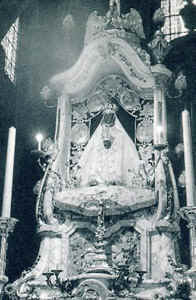 We must not fail to mention one royal pilgrim, to whom Puy stood indebted for the miraculous image of Our Lady, which for many centuries was the object of extraordinary devotion, not only in France, but throughout Europe. It was brought from the Holy Land and deposited in the Basilica in the year 1254, by Saint Louis the King himself, who at the same time presented to the church a thorn from the Holy Crown. The image was of great antiquity, carved in very hard wood, and represented the Blessed Virgin seated and holding the Divine Child on her knees. It was first carried in procession, by way of solemn thanksgiving for the safe return of its royal donor. The Holy Image was very rarely afterwards carried in public, and only on the most solemn occasions. At such times the ceremony was performed with the greatest splendor. Four nobles of the highest rank were chosen to carry the image, and four others, styled the Barons of Our Lady, held the canopy. These processions were made to implore the intercession of the Blessed Virgin when the country was afflicted by famine, pestilence, or war.
We must not fail to mention one royal pilgrim, to whom Puy stood indebted for the miraculous image of Our Lady, which for many centuries was the object of extraordinary devotion, not only in France, but throughout Europe. It was brought from the Holy Land and deposited in the Basilica in the year 1254, by Saint Louis the King himself, who at the same time presented to the church a thorn from the Holy Crown. The image was of great antiquity, carved in very hard wood, and represented the Blessed Virgin seated and holding the Divine Child on her knees. It was first carried in procession, by way of solemn thanksgiving for the safe return of its royal donor. The Holy Image was very rarely afterwards carried in public, and only on the most solemn occasions. At such times the ceremony was performed with the greatest splendor. Four nobles of the highest rank were chosen to carry the image, and four others, styled the Barons of Our Lady, held the canopy. These processions were made to implore the intercession of the Blessed Virgin when the country was afflicted by famine, pestilence, or war.
Their confidence in the protection of Our Lady knew no bounds; "Puy was the city of Mary;" and it was the proud boast of her citizens that she had never opened her gates to a conqueror. Again and again the heretical Huguenots laid siege to the place, but whether they had recourse to stratagem or violence, their efforts were equally frustrated.
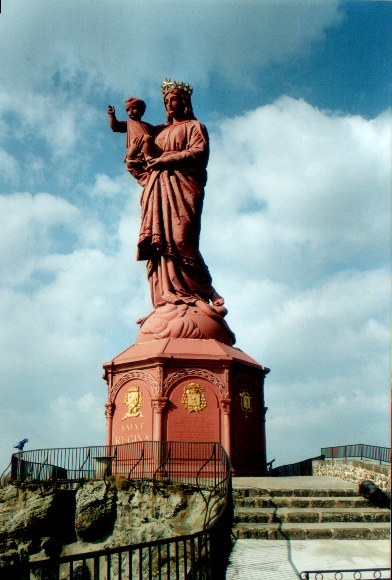 With the passage of time Mount Anis became known as Mount Corneille, and the rock where the miraculous snow had fallen became known as Rocher Corneille. Père de Ravignan, the Abbé Cambalot and Monsignor De Morlhon, the Bishop of Puy, who presided at the jubilee of 1853, conceived the idea of making this rock the pedestal on which should be raised a colossal image of the Mother of God. The rock itself stands 2,460 feet above sea level. On such a pedestal, therefore, the image of the Mother of God might be said to overlook the whole of France, the country long since consecrated to her by one of her old line of princes, and which the crimes of later generations have not succeeded in tearing from her protection. It was a noble design and one worthily executed. The first stone of the pedestal which was to be fixed on the top of the rock was, by the judicious arrangement of the Bishop, to have been laid on the day when the Dogma of the Immaculate Conception was proclaimed by Pope Pius IX, but, circumstances having delayed the ceremony two days, the work commenced on the 10th of December, 1854. Then came the Crimean War, and the idea was suggested by Marshal Pelissier of applying to the Emperor Napoleon III for some of the cannon taken from the Russians, as forming a fit material for the statue of Our Lady of France. Mgr. De Morlhon summoned courage to make the request on the 5th of September, 1855; three days later Sebastapol was in the hands of the Allies, and the 213 cannon taken by the French were, in the following April, granted to the Bishop of Puy by an imperial ordinance. The image was not completed and placed on its pedestal till September 12, 1860, Feast of the Holy Name of Mary, when twelve bishops and an immense throng of clergy and the faithful attended the ceremony which inaugurated Notre Dame de France. The statue is described as not only regal, but very inspiring. It measures, with its pedestal, about 67 feet, and its weight is about 330,000 pounds. It represents the Blessed Virgin crushing the serpent's head under her foot, while in her arms she bears the Divine Child, whose hand is raised as if in the act of blessing France. The Feast of Notre Dame de Puy was originally celebrated on the Sunday following September 12 (in honor of the anniversary of the dedication of the colossal monument), but has since been fixed on September 9 – the day following the Feast of the Nativity of Mary.
With the passage of time Mount Anis became known as Mount Corneille, and the rock where the miraculous snow had fallen became known as Rocher Corneille. Père de Ravignan, the Abbé Cambalot and Monsignor De Morlhon, the Bishop of Puy, who presided at the jubilee of 1853, conceived the idea of making this rock the pedestal on which should be raised a colossal image of the Mother of God. The rock itself stands 2,460 feet above sea level. On such a pedestal, therefore, the image of the Mother of God might be said to overlook the whole of France, the country long since consecrated to her by one of her old line of princes, and which the crimes of later generations have not succeeded in tearing from her protection. It was a noble design and one worthily executed. The first stone of the pedestal which was to be fixed on the top of the rock was, by the judicious arrangement of the Bishop, to have been laid on the day when the Dogma of the Immaculate Conception was proclaimed by Pope Pius IX, but, circumstances having delayed the ceremony two days, the work commenced on the 10th of December, 1854. Then came the Crimean War, and the idea was suggested by Marshal Pelissier of applying to the Emperor Napoleon III for some of the cannon taken from the Russians, as forming a fit material for the statue of Our Lady of France. Mgr. De Morlhon summoned courage to make the request on the 5th of September, 1855; three days later Sebastapol was in the hands of the Allies, and the 213 cannon taken by the French were, in the following April, granted to the Bishop of Puy by an imperial ordinance. The image was not completed and placed on its pedestal till September 12, 1860, Feast of the Holy Name of Mary, when twelve bishops and an immense throng of clergy and the faithful attended the ceremony which inaugurated Notre Dame de France. The statue is described as not only regal, but very inspiring. It measures, with its pedestal, about 67 feet, and its weight is about 330,000 pounds. It represents the Blessed Virgin crushing the serpent's head under her foot, while in her arms she bears the Divine Child, whose hand is raised as if in the act of blessing France. The Feast of Notre Dame de Puy was originally celebrated on the Sunday following September 12 (in honor of the anniversary of the dedication of the colossal monument), but has since been fixed on September 9 – the day following the Feast of the Nativity of Mary.
Champions of Catholic Orthodoxy
Saint Rose of Viterbo, Virgin (†1252)
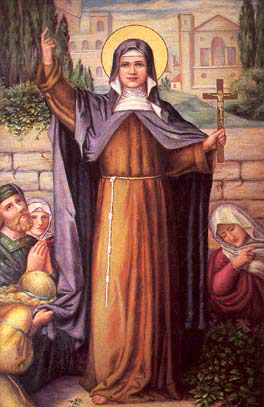 Saint Rose was born of poor and pious parents, in the spring of 1235, a time when Emperor Frederick II was oppressing the Church and many were faithless to the Holy See. Frederick at first had seemed faithful to his duty to protect the Holy See, but eventually he became blinded by ambition. His goal was to restore the "Roman empire over the world." Rome would be the capital of the world, and Frederick would be the real emperor of the Romans. To accomplish this, Frederick published an energetic manifesto denouncing the "world empire" of the Papacy. It was but one more example of those who would destroy true Authority in the name of "reform." Pope Gregory IX excommunicated the "self-confessed heretic," the "blasphemous beast of the Apocalypse" (March 20, 1239). Frederick now attempted to conquer the rest of Italy, i.e. the Papal States. His son Enrico captured in a naval battle all of the Prelates who by the command of His Holiness Pope Gregory were coming from Genoa to Rome to assist at a General Council. After His death (August 22, 1241), the Holy See remained vacant for almost two years save for the short reign of Pope Celestine IV.
Saint Rose was born of poor and pious parents, in the spring of 1235, a time when Emperor Frederick II was oppressing the Church and many were faithless to the Holy See. Frederick at first had seemed faithful to his duty to protect the Holy See, but eventually he became blinded by ambition. His goal was to restore the "Roman empire over the world." Rome would be the capital of the world, and Frederick would be the real emperor of the Romans. To accomplish this, Frederick published an energetic manifesto denouncing the "world empire" of the Papacy. It was but one more example of those who would destroy true Authority in the name of "reform." Pope Gregory IX excommunicated the "self-confessed heretic," the "blasphemous beast of the Apocalypse" (March 20, 1239). Frederick now attempted to conquer the rest of Italy, i.e. the Papal States. His son Enrico captured in a naval battle all of the Prelates who by the command of His Holiness Pope Gregory were coming from Genoa to Rome to assist at a General Council. After His death (August 22, 1241), the Holy See remained vacant for almost two years save for the short reign of Pope Celestine IV.
Throughout all this, the infant Rose seemed filled with grace from her birth; with tottering steps she sought Jesus in His tabernacle, she knelt before sacred images, she listened to pious conversation, retaining all she heard. When but three years old, she raised to life her maternal aunt. At the age of seven, she had already lived the life of a recluse, devoting herself to penances. One coarse habit covered her body; fasts and disciplines were her delight.
Pope Innocent IV ascended the Papal Throne on June 15, 1243. Frederick offered some concessions, but it was clear that he was bent on having the Papal States. The Pope secretly left Rome, arrived at Lyons on December 2, 1244, and early in 1245 summoned the Bishops and princes to a Council there. The First Council of Lyons opened on June 28, but waited for the absent Frederick for three weeks. When he still failed to arrive, the Council passed sentence of excommunication, and the Pope declared Frederick deposed of his imperial authority. This caused great turmoil in Germany, as the clergy generally supported the Pope, but the nobility generally supported Frederick (thus helping to set the stage for the Protestant revolution centuries later). Meanwhile in Italy, Frederick continued to gain control over Papal territory.
Viterbo, too, fell to the imperial power (the Ghibellines); but here, in a sickly little girl, the mighty Frederic would find one of his greatest foes. To defend the Church's rights was her burning wish, and for this she received her mission from the Mother of God. After restoring her health, Our Lady gave Rose the Franciscan habit, with the command to enroll herself in the Third Order of St. Francis and then to go forth and admonish her native town. When hardly twelve years old, Rose went down to the public square at Viterbo, called upon the inhabitants to be faithful to the Sovereign Pontiff, and vehemently denounced all his opponents. So great was the power of her word, and of the miracles which accompanied it, that the Ghibellines, in fear and anger, drove her from the city in January, 1250. Rose and her parents took refuge in Sorriano. On December 5, 1250, Rose foretold the speedy death of the emperor, a prophecy realized on December 13. Soon afterwards she went to Vitorchiano, whose inhabitants had been perverted by a famous sorceress. Rose secured the conversion of all, even of the sorceress, by standing unscathed for three hours in the flames of a burning pyre, a miracle as striking as it is well attested.
Pope Innocent IV was brought back in triumph to Rome and the cause of God was won. With the restoration of the papal power in Viterbo (1251) Rose returned. She wished to enter the monastery of St. Mary of the Roses, but was refused because of her poverty. She humbly submitted, foretelling her admission to the monastery after her death. The remainder of her life was spent in the cell in her father's house, where she died in her eighteenth year. Not long after, she appeared in glory to Pope Alexander IV, and bade him translate her body. He found it as the vision had said, but fragrant and beautiful, as if still in life. Her feast is celebrated on Sept. 4th, when her incorrupt body is carried in procession through Viterbo.
St. Lambert, Bishop & Martyr (†709)
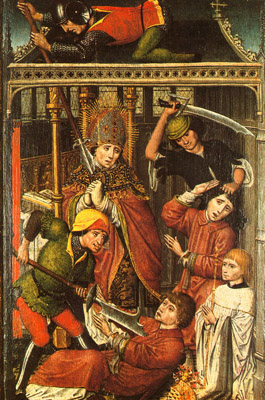 St. Lambert was born in Maastricht (now in southern Holland). His father entrusted his education to the holy Bishop St. Theodard, and on that good man being martyred, Lambert was chosen as his successor. A revolution breaking out which overturned the kingdom of Austrasia, Lambert was banished from his See on account of his loyalty to his rightful king. He retired to the monastery of Stavelo, and there obeyed the rule as strictly as the youngest novice. One instance will suffice to show with how perfect a sacrifice of himself he devoted his heart to serve God. As he was rising one night in winter to his private devotions, he happened to let fall his wooden sandal. The abbot, without asking who had caused the noise, gave orders that the offender should go and pray before the cross, which stood before the church door. Lambert, without making any answer, went out as he was, barefoot, and covered only with his hair shirt; and in this condition he prayed, kneeling before the cross, where he was found some hours after. At the sight of the holy Bishop, the Abbot and the monks fell on their knees and asked his pardon. "God forgive you," said he, "for thinking you stand in need of pardon for this action. As for myself, is it not in cold and nakedness that, according to St. Paul, I am to tame my flesh and to serve God?"
St. Lambert was born in Maastricht (now in southern Holland). His father entrusted his education to the holy Bishop St. Theodard, and on that good man being martyred, Lambert was chosen as his successor. A revolution breaking out which overturned the kingdom of Austrasia, Lambert was banished from his See on account of his loyalty to his rightful king. He retired to the monastery of Stavelo, and there obeyed the rule as strictly as the youngest novice. One instance will suffice to show with how perfect a sacrifice of himself he devoted his heart to serve God. As he was rising one night in winter to his private devotions, he happened to let fall his wooden sandal. The abbot, without asking who had caused the noise, gave orders that the offender should go and pray before the cross, which stood before the church door. Lambert, without making any answer, went out as he was, barefoot, and covered only with his hair shirt; and in this condition he prayed, kneeling before the cross, where he was found some hours after. At the sight of the holy Bishop, the Abbot and the monks fell on their knees and asked his pardon. "God forgive you," said he, "for thinking you stand in need of pardon for this action. As for myself, is it not in cold and nakedness that, according to St. Paul, I am to tame my flesh and to serve God?"
While St. Lambert enjoyed the quiet of holy retirement, he wept to see the greatest part of the churches of France laid waste. In the meantime the political clouds began to break away, and St. Lambert was restored to his See. Trouble of another sort would soon be the occasion of the holy Bishop's martyrdom.
King Pepin of Heristal lived for many years in irreproachable wedlock with the pious Plectrude, who bore him two sons. Later he entered into unlawful relations with Alpais, who became the mother of Charles Martel. When no one had the courage to remonstrate with Pepin, Lambert went to his court like another John the Baptist. Alpais, fearing that Pepin might heed the admonitions of the saint, appealed to her brother Dodo. The latter sought revenge and caused Bishop Lambert to be assassinated in the chapel of Sts. Cosmas and Damian, built by St. Monulphus at Liège. His heart was pierced by a javelin while he was at the altar on the 17th of September, 709. Some years later, St. Hubert exhumed the relics of St. Lambert and had them enshrined at Liège.
Visit also: www.marienfried.com
